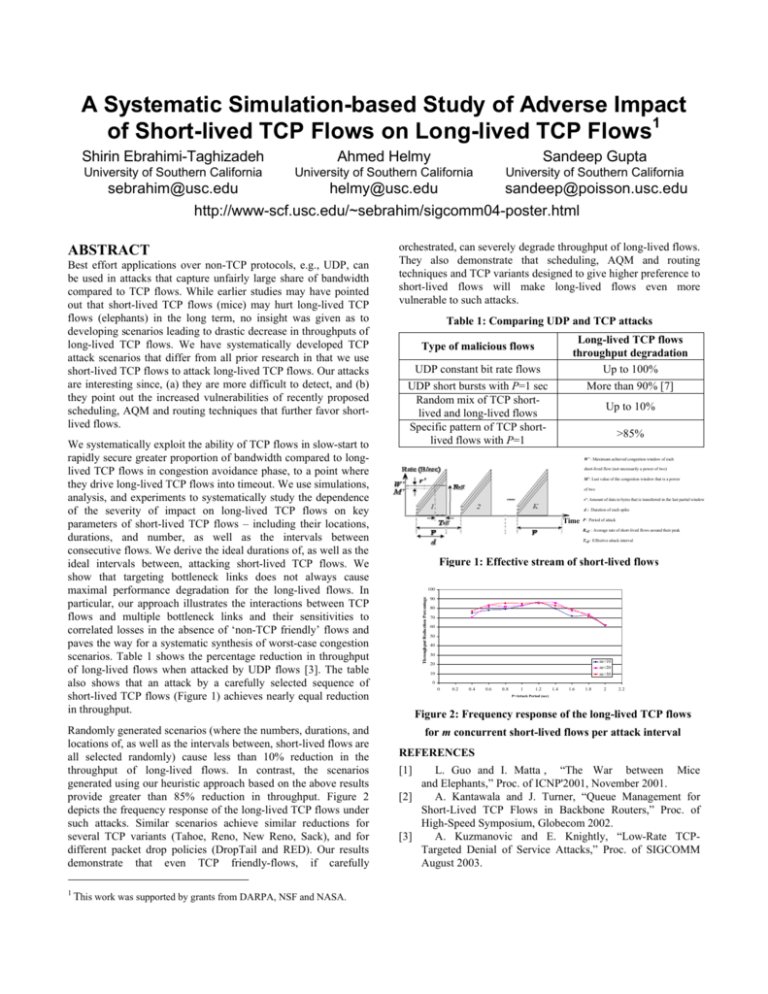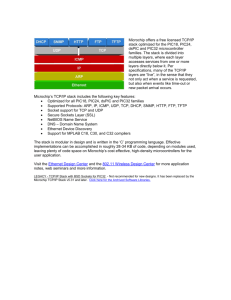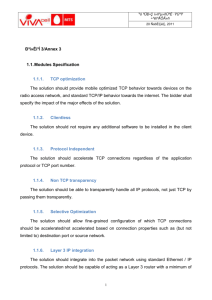A Systematic Simulation-based Study of Adverse Impact
advertisement

A Systematic Simulation-based Study of Adverse Impact of Short-lived TCP Flows on Long-lived TCP Flows1 Shirin Ebrahimi-Taghizadeh Ahmed Helmy Sandeep Gupta University of Southern California University of Southern California University of Southern California sebrahim@usc.edu helmy@usc.edu sandeep@poisson.usc.edu http://www-scf.usc.edu/~sebrahim/sigcomm04-poster.html Best effort applications over non-TCP protocols, e.g., UDP, can be used in attacks that capture unfairly large share of bandwidth compared to TCP flows. While earlier studies may have pointed out that short-lived TCP flows (mice) may hurt long-lived TCP flows (elephants) in the long term, no insight was given as to developing scenarios leading to drastic decrease in throughputs of long-lived TCP flows. We have systematically developed TCP attack scenarios that differ from all prior research in that we use short-lived TCP flows to attack long-lived TCP flows. Our attacks are interesting since, (a) they are more difficult to detect, and (b) they point out the increased vulnerabilities of recently proposed scheduling, AQM and routing techniques that further favor shortlived flows. We systematically exploit the ability of TCP flows in slow-start to rapidly secure greater proportion of bandwidth compared to longlived TCP flows in congestion avoidance phase, to a point where they drive long-lived TCP flows into timeout. We use simulations, analysis, and experiments to systematically study the dependence of the severity of impact on long-lived TCP flows on key parameters of short-lived TCP flows – including their locations, durations, and number, as well as the intervals between consecutive flows. We derive the ideal durations of, as well as the ideal intervals between, attacking short-lived TCP flows. We show that targeting bottleneck links does not always cause maximal performance degradation for the long-lived flows. In particular, our approach illustrates the interactions between TCP flows and multiple bottleneck links and their sensitivities to correlated losses in the absence of ‘non-TCP friendly’ flows and paves the way for a systematic synthesis of worst-case congestion scenarios. Table 1 shows the percentage reduction in throughput of long-lived flows when attacked by UDP flows [3]. The table also shows that an attack by a carefully selected sequence of short-lived TCP flows (Figure 1) achieves nearly equal reduction in throughput. Randomly generated scenarios (where the numbers, durations, and locations of, as well as the intervals between, short-lived flows are all selected randomly) cause less than 10% reduction in the throughput of long-lived flows. In contrast, the scenarios generated using our heuristic approach based on the above results provide greater than 85% reduction in throughput. Figure 2 depicts the frequency response of the long-lived TCP flows under such attacks. Similar scenarios achieve similar reductions for several TCP variants (Tahoe, Reno, New Reno, Sack), and for different packet drop policies (DropTail and RED). Our results demonstrate that even TCP friendly-flows, if carefully 1 This work was supported by grants from DARPA, NSF and NASA. orchestrated, can severely degrade throughput of long-lived flows. They also demonstrate that scheduling, AQM and routing techniques and TCP variants designed to give higher preference to short-lived flows will make long-lived flows even more vulnerable to such attacks. Table 1: Comparing UDP and TCP attacks Long-lived TCP flows throughput degradation Up to 100% More than 90% [7] Type of malicious flows UDP constant bit rate flows UDP short bursts with P=1 sec Random mix of TCP shortlived and long-lived flows Specific pattern of TCP shortlived flows with P=1 Up to 10% >85% W’ : Maximum achieved congestion window of each short-lived flow (not necessarily a power of two) M’: Last value of the congestion window that is a power of two r': Amount of data in bytes that is transferred in the last partial window d : Duration of each spike Time P : Period of attack Reff : Average rate of short-lived flows around their peak Teff : Effective attack interval Figure 1: Effective stream of short-lived flows 100 Throughput Reduction Percentage ABSTRACT 90 80 70 60 50 40 30 m=10 m=20 m=30 20 10 0 0 0.2 0.4 0.6 0.8 1 1.2 1.4 1.6 1.8 2 2.2 P=Attack Period (sec) Figure 2: Frequency response of the long-lived TCP flows for m concurrent short-lived flows per attack interval REFERENCES [1] L. Guo and I. Matta , “The War between Mice and Elephants,” Proc. of ICNP'2001, November 2001. [2] A. Kantawala and J. Turner, “Queue Management for Short-Lived TCP Flows in Backbone Routers,” Proc. of High-Speed Symposium, Globecom 2002. [3] A. Kuzmanovic and E. Knightly, “Low-Rate TCPTargeted Denial of Service Attacks,” Proc. of SIGCOMM August 2003.








